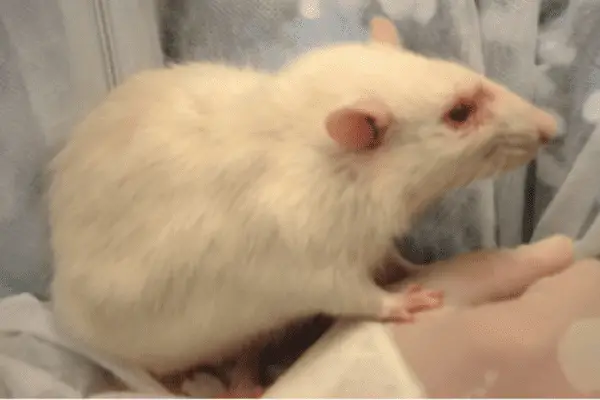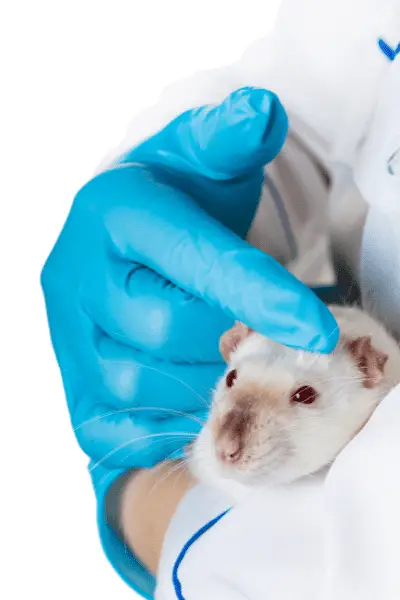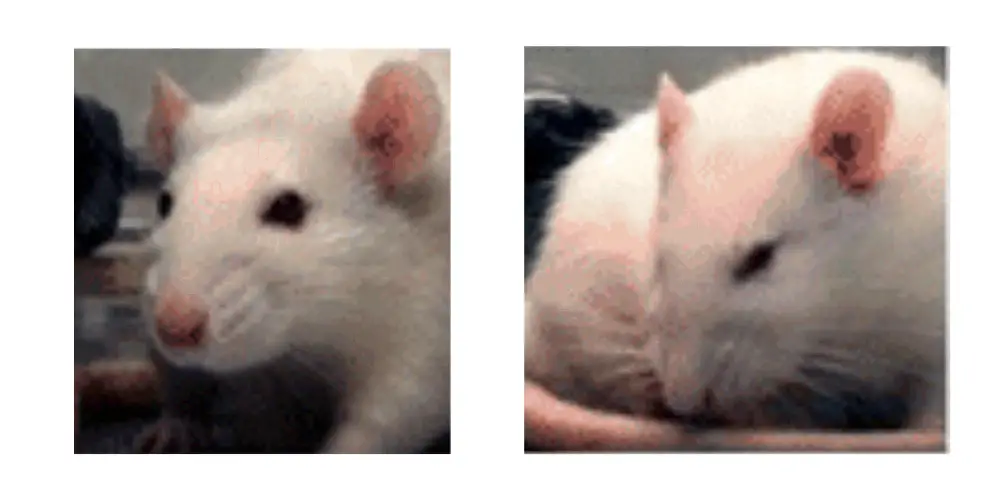As a prey species, rats’ instinct causes them to be extremely good at hiding symptoms of illness. Thus, in the wild, a rat that appears sick will be prone to be caught as soon as a predator notices it seems to be under the weather.
This article serves as a guide on when to take your pet rat to the vet and when a disease may not be as serious.
Be Familiar With What Is Normal For Rats
I wrote an article on how to do a physical exam on your pet rat at home with details on what exactly is considered normal for pet rats. It also contains a handy table with all the normal parameters for pet rats. So have a read here for a step-by-step guide to doing a physical exam on your pet rat at home.

How Often Should I Take My Pet Rat To The Vet?
Rats should have a health check at least once a year for the first 2 years of their life and then at least every 6 months from thereon. As they age, they become prone to many diseases. Generally speaking, the sooner a disease is addressed, the better the outcome of treatment.
It is essential to establish a relationship with a vet in your area who is familiar with rats. Even if you have years of experience with caring for rats, a vet can be a beneficial ally in the interest of keeping your rats healthy.
Having an experienced and knowledgeable set of hands look at your rat can help detect problems earlier, even before you might have noticed that anything is wrong. Vets often help pet rat owners detect subtle problems such as small, potentially cancerous growths and dental problems that can cause weight loss and pain.
You should take your pet rat for its first vet visit within the first 3 days of getting your pet rat. This is to ensure that you acquired a healthy rat and discuss routine preventative care such as deworming or neutering with your vet. Rats from high-density living conditions, such as high-volume breeders or pet shops, are prone to having internal and external parasites.
If you would like to read more about how you can support an aging rat using nutrition, have a look at this article on what to feed a senior rat to keep them healthy.
Signs Of Illness in Rats
When you are familiar with what is normal for your pet rat and have an idea of how active they are and how much time they spend doing different activities, you will notice changes or abnormalities much sooner.
I also advise all rat owners to weigh their rats weekly to notice upward or downward trends in their rat’s weight. Small fluctuations from week to week are normal. Still, if you start noticing that they are consistently losing weight for weeks at a time without you intentionally reducing food, it is definitely a warning sign that something is going on.
The following are signs of illness to look out for:
Porphyrin staining around the eyes
Rats have a tear gland behind their eyes (the Harderian Gland) that tends to increase tear production when a rat is ill or stressed and contains a compound called porphyrin. When this compound reacts with UV light, it creates a brown discoloration that will stain the fur.
This is a convenient sign for pet rat owners to look out for as healthy young rats will not have porphyrin staining around the eyes.

Breathing Faster or Harder
A rat’s breathing should be quiet and effortless, with only a slight movement of the chest visible.
Any changes in breathing rate or effort could indicate respiratory or heart disease. Rats are prone to respiratory diseases such as pneumonia caused by many different bacterial and viral agents.
Rats are also prone to heatstroke as they can not pant, and the only areas of their body that can dissipate heat are their tail, ears, and feet. However, this is a tiny surface area when compared to the rest of their bodies. As a result, heatstroke will often present with increased breathing rate and open mouth breathing, lethargy, and even unconsciousness.
Breathing faster or with an increased effort or heaving means that you should get your pet rat to the vet right away!
Nasal Discharged or Sneezing
A runny or crusty nose, upper respiratory noises, and sneezing are often the first signs of a respiratory tract infection. Unfortunately, this can sometimes progress to affecting the lower respiratory tract causing pneumonia which can be life-threatening.
If an infection can be treated and stopped in its tracks before progressing to affecting the lungs, the outcome of treatment is often better, and recovery is quicker.
Eating Less Than Usual/Not Eating/Weight Loss
Rats are opportunistic eaters meaning that they often eat when food is available. This is why they will never say no to their favorite treat, even after just having eaten an entire meal. For this reason, it would be considered strange for a rat to refuse their favorite treat.
If you notice that your rat starts leaving leftovers or starts hiding food that they usually loved, this could be the first clue of a declining appetite.
Being Less Active or Sleeping More Than Usual
If your rat seems to be sleeping more than usual or does not greet you when you come to the cage as they usually did, it should raise alarm bells.
If your rat suddenly does not engage in a game of hand chasing/wrestling that they used to love, it means that their energy levels are down or that they are feeling under the weather. This, concurrent with other symptoms, definitely warrant a vet visit.
Gradual reduction in activity levels as a rat ages, is normal. Sudden on severe lethargy is not and should be investigated as soon as possible.
Unkempt Coat
Older rats may start to spend less time grooming themselves; however, they should not completely quit grooming. Even a three-year-old rat should attempt to keep themselves clean.
If you find that your rat starts looking rather scruffy, it is usually an indication of some chronic or slow-progressing condition.
Hair Loss or Constant Scratching
This is commonly a sign of ectoparasites such as fleas, mites, or lice. Although, hair loss can also be a symptom of certain metabolic or endocrine diseases or skin infections.
A good first step would be to speak to your vet to get an appropriate ectoparasiticide as a first-line treatment.
If the hair loss or itching persists or is severe, your vet will be able to help relieve itching and identify the underlying cause.
Lumps Anywhere on The Body
Rats are very prone to tumors, but they also get abscesses. Both are serious and should be checked out as soon as possible.
Abscesses are painful and usually need draining under sedation and antibiotics. If an abscess is left untreated, it can lead to the infection spreading and, eventually, septicemia (read critically ill and potentially death).
Malignant tumors are common in rats. This means that tumors are usually invasive, quick-growing, and spread to internal organs such as lymph nodes, lungs, and liver. Therefore, the earlier the tumors are addressed, the better the prognosis, as complete remission is difficult to achieve once tumor cells have spread to other organs.
Surgical excision is often the treatment of choice, depending on the location of the tumor.
Wounds
Sure, rats are known that their wounds heal faster than most other species, but the wound severity is often underestimated at first glance, and infection can be deadly.
If you notice a wound on your rat, have it evaluated by a vet to ensure it does not affect vital structures and get the appropriate pain medication and antibiotics if needed.
Wounds can be very deceptive. When I surgically explore wounds, it is common to find that the wound extends much further under the skin or that there is much more internal injury than first anticipated.
Discomfort Of The Eyes/Runny/Swollen Eyes
Any squinting, constant blinking, runny eyes, or swelling around the eyes is a good reason to take your rat to the vet as soon as possible.
Eyes can go very wrong very fast and may end up with your rat losing vision and even an eye. So, this is definitely something you would want to get checked out as soon as possible.
Abnormal Posture
A head tilt (also known as wry neck) could indicate many serious conditions and need urgent attention. Unfortunately, this condition is often confused with wryneck in avian species, most commonly caused by a nutritional deficiency. In contrast, it can be a symptom of inner ear infection, brain tumors, nervous system conditions, or stroke in rats.
Dragging of the hind legs or a wobbly or uncoordinated gait also warrants an urgent vet visit. Some of the causes of these symptoms are not always 100% treatable, but even if not, your vet will be able to help you make your rat comfortable and help control pain.

Have a look at this table by MSD Veterinary Manual for symptoms of common diseases in pet rats.
How To Know If My Rat Is In Pain?
Since rats are a prey species, they will often try to hide signs of pain or illness. Signs indicating pain in rats include hunched posture, decreased appetite, aggression, and avoidance behaviors. Rats experiencing pain also have a ‘pain’ facial expression characterized by slanted eyes, flattened ears, and whiskers pointing away from the body.

A vet needs to see any rat you think might be experiencing pain to prescribe the correct dose of rat-safe pain medication.
No rat ever deserves to be in pain.
I Think My Rat Is Busy Dying, What Should I Do?
I am a huge advocate for preventing or ending suffering. If you think that your rat may be near their end (and owners often have a good sense of when this is – trust yourself!), having them humanely euthanized by your vet may be the kindest thing you can do for your rat in such a situation—Euthanasia, when done correctly and by a veterinarian, is painless.
At the very least, let your vet have a look and help you make the decision. Sometimes our judgment becomes clouded with emotion when our own pets are having a difficult time. Having a trusted vet by your side in situations like these will help you to make a decision in the best interest of your beloved rat.
A vet mentor of mine once said, by euthanizing, you, as owner, are taking your pet’s pain so that they can be pain-free.
It is hard to let them go, but sometimes it is the best thing we can do for them.
Final Thoughts
I sometimes have had owners bring their pets in because they think it might be time to let them go and then find that what is ailing them is treatable or at the very least manageable. This is one of the reasons why regular checkups are so vitally important. By doing this, you help your vet to help your rat by addressing health concerns before they start affecting your rat’s quality of life in a negative way.
References
- Banks, R., 2013. Exotic small mammal care and husbandry. Hoboken: John Wiley, pp.81 – 92. https://onlinelibrary.wiley.com/doi/book/10.1002/9781119265405
- Meredith, A. and Redrobe, S., 2002. BSAVA manual of exotic pets. 4th ed. Quedgeley: British Small Animal Veterinary Association, pp.13 – 25. https://www.researchgate.net/publication/240493099_The_BSAVA_Manual_of_Exotic_Pets_4th_edn
- O’Malley, B., 2005. Clinical anatomy and physiology of exotic species. Elsevier, pp.209 – 225. https://www.sciencedirect.com/book/9780702027826/clinical-anatomy-and-physiology-of-exotic-species
